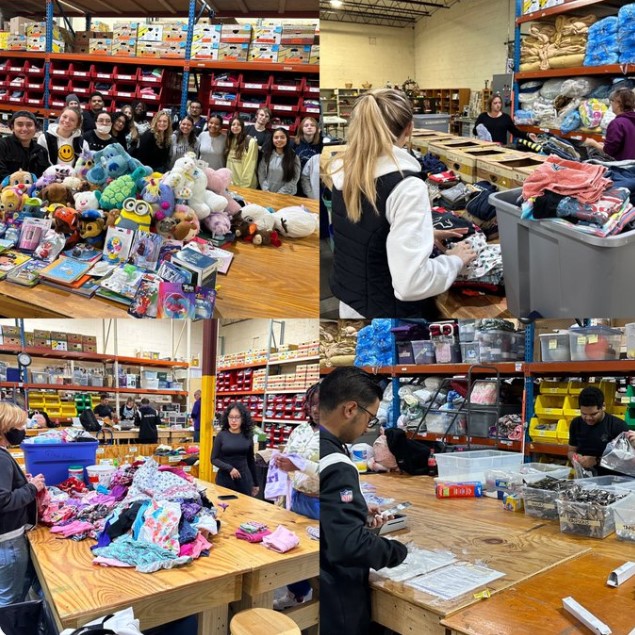Anne Arundel County Public Schools, 2023
Eleventh and twelfth grade students at Glen Burnie High School created a service-learning project in support of the mission of Hope for All. After learning about the needs of the community in a public service explorations course, students designed a service-learning project called Books and Bedtime Buddies. This project involved the whole school participating in a drive for books and stuffed animals for children from ages birth to eight. Students created posters and announcements with information about the importance of literacy for young children.
Best Practice 1: Meet a Recognized Need in the Community
Students were able to collect literature and toys for children, provide education about the need for literacy for student success, and assist at a local neighborhood warehouse with necessities for the community.
Best Practice 2: Achieve Curricular Objectives through Service-Learning
Objectives addressed included research, communication, community engagement, collaboration, and leadership through project design.
Best Practice 3: Reflect throughout the Service-Learning Experience
Throughout the month-long initiative, students reflected multiple times through group discussions and two written reflections, one focused on personal goals and the other on group goals.
Best Practice 4: Develop Student Responsibility
Students were able to lead in various ways. They had four committees, one that helped with marketing the drive, another focused on researching the types of books appropriate for different ages, a collections team, and a field trip leadership team.
Best Practice 5: Establish Community Partnerships
The Glen Burnie High School Signature Program sponsored the field trip transportation, Hope for All was the recipient of the collections that will benefit their organization’s mission.
Best Practice 6: Plan Ahead for Service-Learning
This service-learning experience took place in a course designed for project-based learning. Teachers planned for this by engaging the students in lessons on community needs and in Socratic Seminars on civic engagement.
Best Practice 7: Equip students with Knowledge & Skills needed for Service
The curriculum for this Public Service 2 course is heavily focused on the community. The students were able to apply what they learned about project design to their knowledge of civic engagement to create a meaningful service learning project.

Wicomico County Public Schools, 2023
High School English Language Learners (ELL) through the Newcomer Center: English Language Support Center wrote bilingual story books for local elementary school students. ELL students attending the Newcomer Center have limited English proficiency and generally have been in a United States school for under one year. For this project, the students each wrote and illustrated part of a book that was published using
Studentreasures. The students each took materials home to complete them. They practiced reading in English. Additional students wrote and illustrated interactive tangram puzzle books to teach young children geometric concepts. Books were shared with the students at the elementary school.
Best Practice 1: Meet a Recognized Need in the Community
ESOL students provided educational tools to younger students to help introduce them to another language, while also teaching reading and geometry skills on a grade-appropriate level.
Best Practice 2: Achieve Curricular Objectives through Service-Learning
Student authors practiced the English and Math skills learned in class, while also using those skills to develop a learning tool for elementary students.
Best Practice 3: Reflect throughout the Service-Learning Experience
Students had to consider the use of correct grammar and the English language, as well as correct geometrical material to present in the books to make the learning relevant and beneficial to the younger students.
Best Practice 4: Develop Student Responsibility
Students were responsible for the development of the books and the storyline involved in the bilingual English book. They also developed age-appropriate puzzle books to help teach math concepts. Teachers were available for support as the implementation was completed by the students.
Best Practice 5: Establish Community Partnerships
Students served an elementary school within the Wicomico County school system.
Best Practice 6: Plan Ahead for Service-Learning
Students had to learn how to use the programs involved in developing the books, plan for the storylines and geometric shapes, and develop a plan to share the responsibilities of the development of the books. They also had to use resources to ensure they were using the languages appropriately.
Best Practice 7: Equip students with Knowledge & Skills needed for Service
Students were able to demonstrate their growth in proficiency of the English language through the creation of their books.
Contact:
Lauren McKinley, M.Ed.
Service-Learning Specialist, Youth Development Branch
Office: (410) 767-0357
lauren.mckinley@maryland.gov
Reginald Burke, M.S.
Director, Youth Development Branch
Office: (410) 767-0313
reginald.burke@maryland.gov